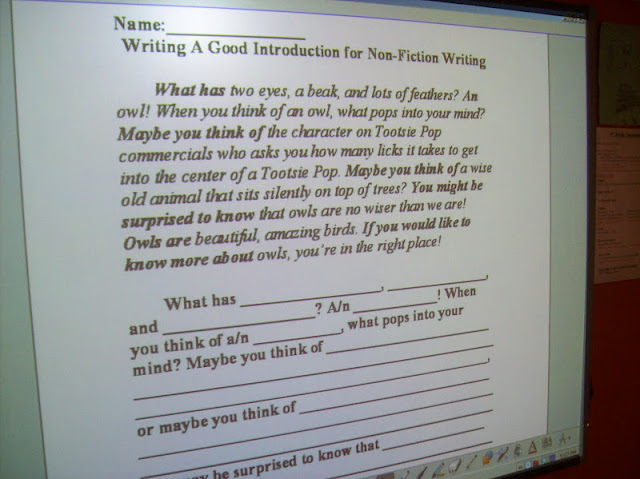Now that we had the body of our animal reports written (the paragraphs about habitat, diet, and defense mechanisms), it was time for students to write their introductions. A good introduction HOOKS a reader into wanting to read more!
In order to know how to write an introduction that hooks a reader, we analyzed several introductions from real non-fiction authors to see how they did it! This introduction came from a book about pelicans. We noticed that this introduction included DESCRIPTION and QUESTIONS.
This introduction came from a book on wolves. We noticed that this author also asked QUESTIONS, CONNECTED TO OUR SCHEMA, and shared SURPRISING INFORMATION.
And in this introduction from a book on owls, the author PAYS THE ANIMAL A COMPLIMENT and INVITES THE READER to read more.
We added all this great information to our organization anchor chart we created earlier in the year. (All of our new learning is in orange.)
To help scaffold my kiddos into writing an introduction that included all of the 'hooking characteristics' we learned from the mentor texts we analyzed, I wrote my own introduction for my own report on owls and also created a template for students.
Students wrote their own introductions using the template so that their introduction would HOOK US! This template and all the other sheets students have and will be using in this unit can be found here! :)
Here is the introduction Casey wrote for his report on lynx!
Here is the introduction Blake wrote for his report on deer!
Tomorrow, we will be following this same process for writing our conclusions to our animal reports.
----
Our third quarter reading genre focus is BIOGRAPHY. Yesterday I introduced the genre to our kids. I also listed several characteristics of most biographies. Prior to my lesson, I put post-its where I located all of the features and showed each example as we filled in the anchor chart of all the characteristics.
For guided practice, we handed out biography books to pairs of students. We asked them to page through their books to see if they, too, could locate all the characteristics of a biography.
Here's some footage of their biography characteristic hunt!
Students got a chance to share their discoveries. One of the discoveries was that it was a little difficult to locate the birth information. It didn't appear on the first page as students had thought! This student-initiated discovery became my mini-lesson for today. :) (I love it when that happens!)
Today we zoomed in on characteristic #5: Chronological order. I had specifically left a box on our anchor chart from yesterday so that I could address the unique structure of most biographies - the first chapter or introduction is written to HOOK US, then the next part of the book goes into the beginning of the person's life.

For guided practice today, students got another biography book and analyzed the first chapter/introduction to identify how it hooked them, followed by locating the birth information in the next chapter. Students used the sentence stems on the chart to formulate their response for when we shared. This study of introductions really went hand-in-hand with our lesson in Writer's Workshop on writing an introduction for our animal research! (Again, I love it when that works out!) To see the next lessons from our biography unit, click here!











I love how thorough your writing lessons are with your students. I see now after this post {you may have said so earlier...but this is the first time I've caught on}, that you focus on one genre of writing per quarter. Is this due to curriculum mapping? I would love to plan my writing this way next year. I can see from all of your previous posts that your students clearly "get it". I'm very impressed.
ReplyDeleteThank you for your fabulous blog.
Elizabeth {a fellow 4Ber}
Fun in Room 4B
Once again another wonderful lesson created and executed by you. I am so inspired!
ReplyDeleteThanks, you two! :)
ReplyDelete@ Elizabeth - Our district has established quarterly genre focuses (foci?) for both reading and writing for every grade level, which means we are to do an intense study (around two weeks) of those genres. For fourth-grade for reading we have informational/everyday text, historical fiction, biography, and poetry. Our fourth-grade writing genres are response to literature, summarizing, non-fiction report, and poetry. By assigning grade levels to genres, we are ensure kids are getting intense instruction on each genre at least once in their elementary lives in our district. This doesn't mean we don't teach the other genres, it just means we can focus our teaching a little more since there are SO many things to teach! :)
Well, I love it. I'd love to do this next year. I really think your students must be getting a lot out of it. Again, thanks for sharing.
ReplyDeleteAnd-thanks for responding so quickly.
Elizabeth
Fun in Room 4B
I am about to start a study of biographies with my 4th graders. Thanks for giving me a great way to begin!
ReplyDeleteIncredible as always. YOU ARE AMAZING! mary at apopovic@primus.ca
ReplyDeleteI just nominated you for an award because you are such an inspiration!
ReplyDeleteElizabeth
Fun in Room 4B
How much time did you spend on this daily and overall on the project. I'm trying to determine if it is possible for my class right now. Also, would you be willing to send me your smarboard lesson you created for it? I'm very interested in this but I'm not super tech savvy. My e-mail address is natalie.bean@lrsd.org
ReplyDeleteThanks so much!
Natalie Bean
Superbly written article, if only all bloggers offered the same content as you, the internet would be a far better place..
ReplyDeleteketo diet lose weight